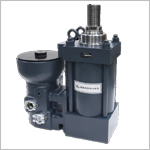VariStroke-I
The VariStroke-I is a linear electro-hydraulic actuator that utilizes a double-acting or single-acting power cylinder (part number dependent) with integrated electronic driver module, servo valve, and MLDT-based position feedback sensors to precisely control steam turbine valves. The actuator’s driver module accepts one or two (redundant) 4–20 mA demand setpoints and compares these setpoints to the sensed actuator shaft position to accurately control output shaft position.
The actuator’s output shaft position is controlled by a digital controller with an internal rotary servo valve that ports supply oil to and from its power cylinder piston. This actuator’s special digital controller architecture allows it to perform very stable position control during normal conditions, and also respond in milliseconds to desired valve step changes during system or plant transients. As a means of protecting the turbine, an internal valve-return spring forces the actuator to a failsafe position to safely close turbine control valves upon any internal unit failure (electrical input power failure, position sensor failure, processor failure, etc.).
The VariStroke-I actuator is a product family with different models available for purchase depending on the force, stroke, and redundancy required. This actuator is available with standard bore diameters, standard stroke ranges, and with single-acting (spring return) or double-acting (pressure return) operation. The VariStroke’s unique “variable stroke” capability also allows users to customize/set the actuator’s exact stroke length in the field to meet their required application.
The VariStroke-I is factory and/or field configurable via a computer-based service tool. The actuator’s PCI Service Tool uses a simple user-friendly format to allow users to easily configure, calibrate, and adjust all internal functions and response settings. The VariStroke-I also includes a 4–20 mA output channel to indicate output shaft (control valve) position, and unit alarm and shutdown relay outputs for use as unit health and status indications.
The total installed cost for this fully integrated actuator is low because it has been completely assembled and tested at the factory. This greatly reduces OEM and end-user fabrication time, testing time, and site assembly time.


